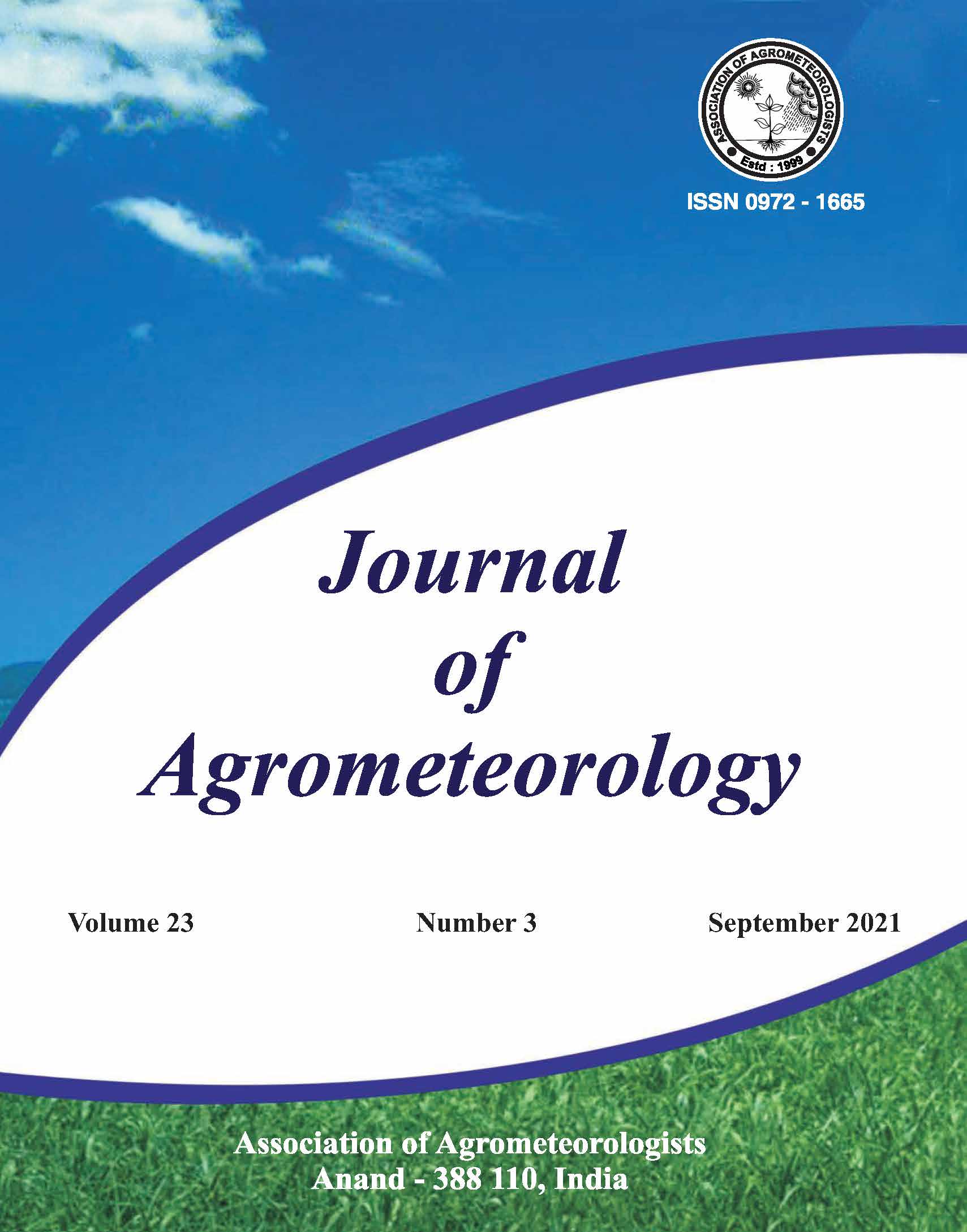Potato late blight disease prediction using meteorological parameters in Northern Himalayas of India
DOI:
https://doi.org/10.54386/jam.v23i3.35Keywords:
Environmental factors, potato late blight, Phytophthora infestansAbstract
Weather parameters play an important role in the spread of potato late blight of caused by Phytophthora infestans (Mont.) de Bary has historically been serious disease of potatoes through worldwide, including India. Due to spatial variation in prevailing weather conditions, its severity varies from region to region. Disease development process and the weather parameters are well understood and have been utilized for disease developing forecasting models and decision support system. Therefore, an experiment was conducted for two consecutive cropping seasons (2017 & 2018) to develop a forecasting model against late blight of potato using stepwise regression analysis for Northern Himalayas in India. Maximum and minimum temperature, relative humidity, rainfall and wind speed appeared to be most significant factors in the potato late blight disease development. The meteorological conditions conducive for the development of potato late blight disease were characterized. Maximum and minimum temperatures in the range of 15.0 – 28.0°C and 2.0 – 12.0°C were found favorable for potato blight disease. Similarly, relative humidity, rainfall and wind speed in the range of 85 - 95 per cent, 15.5 - 20.75 mm and 1.0 - 5.5 Km h-1, respectively, were conducive for potato late blight disease which are helpful in disease development.
References
Andrade-Piedra J.L, Hijmans R.J, Juárez H.S, Forbes G.A and Shtienberg D. (2005). Simulation of potato late blight in the Andes. Validation of the late blight model. J. Phytopathol., 95: 1200-1208.
Arora R. K, Ahmad I. and Singh B.P. (2012). Forecasting late blight of potato in Punjab using JHULSACAST model. Potato J., 39(2): 173-176.
Bhattiprolu, S.L. and Monga, D. (2018). Effect of weather parameters on the development of alternaria leaf spot and grey mildew in cotton. J. Agrometeorol., 20(4):315- 318.
Campbell C.L and Madden L.V. (1990). Introduction to plant disease epidemiology. New York: John Wiley and Sons. Doster M.A, Sweigaird J.A and Fry W.E. (1989). The influence of host resistance and climate on the initial appearance of foliar late blight of potato from infected seed tubers. Am. Potato J., 66: 227-233.
Fry W.E, Apple A.E and Bruhn J.A., (1983). Evaluation of potato late blight forecast modified to incorporate host resistance and fungicide weathering. J Phytopathol., 73: 1054-1059.
Goss E.M, Tabima J.F, Cooke D.E.L, Restrepo S, Fry W.E and Forbes G.A. (2014). The Irish potato famine pathogen Phytophthora infestans originated in central Mexico rather than the Andes. Proc Natl Acad Sci U S A., 111: 8791-8796.
Grenwald, N.J, Rubio-Covarrubias, O. and Fry, W.E. (2000). Potato late blight management and dissemination system using an automated weather monitoring network. Pp. 209-213.
Jenkins J.C and Jones R.K. (2003). Classifying the relative host reaction in potato cultivars and breeding lines to the US-8 strain of Phytophthora infestans in Minnesota. Plant Dis., 87:983-990
Lal, M., Arora R.K, Uma M., Rawal S. and Yadav S. (2016). Impact of late blight occurrence on potato production during 2013-14. Int. J. Agric.
Stat. Sci., 1(12):187-192.
Pundhir V.S., Singh B.P., Ahmas I, Sharma S., Khushwala H.S, Singh V.K. and Josh V. (2014). Forecasting of late blight of potato in Tarai region of
Uttarakhand using JHULSACAST model. Potato J., 41(2): 95-104.
Santosh K, MD Nadeem A, Santosh K, Mahesh K and Tribhuwan K. (2021). Influence of weather parameters on alternaria leaf blight severity of
makhana under the agro-climate of Koshi region of Bihar. J. Agrometeorol., 23 (1): 54-59.
Das, S., Pandey V., Patel H.R. and Patel K.J. (2011). Effect of weather parameters on pest-disease of okra during summer season in middle-Gujarat. J. Agrometeorol., 13(1):38-42.
Shtienberg D. (2010). Applications of epidemiology in the management of Ascochyta blight in chickpea and lentil. In: Compendium of Chickpea and Lentil Diseases and Pests. APS Press, St Paul, Minnesota, USA. Pp 22.
Singh B.P., Ahmad I., Sharma V.C. and Shekhawat G.S. (2000). A computerized forecast of potato late blight in western Uttar Pradesh. J. Indian Potato Assoc., 27: 25-34.
Wilcoxson R.D, Skovmand B and Atif A.H. (1975). Evaluation of wheat cultivars for their ability to retard development of stem rust. Ann. Appl.
Biol., 80:275–281.
Downloads
Published
How to Cite
Issue
Section
License

This work is licensed under a Creative Commons Attribution 4.0 International License.
This is a human-readable summary of (and not a substitute for) the license. Disclaimer.
You are free to:
Share — copy and redistribute the material in any medium or format
Adapt — remix, transform, and build upon the material
The licensor cannot revoke these freedoms as long as you follow the license terms.
Under the following terms:
Attribution — You must give appropriate credit, provide a link to the license, and indicate if changes were made. You may do so in any reasonable manner, but not in any way that suggests the licensor endorses you or your use.
NonCommercial — You may not use the material for commercial purposes.
ShareAlike — If you remix, transform, or build upon the material, you must distribute your contributions under the same license as the original.
No additional restrictions — You may not apply legal terms or technological measures that legally restrict others from doing anything the license permits.
Notices:
You do not have to comply with the license for elements of the material in the public domain or where your use is permitted by an applicable exception or limitation.
No warranties are given. The license may not give you all of the permissions necessary for your intended use. For example, other rights such as publicity, privacy, or moral rights may limit how you use the material.





